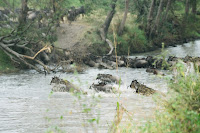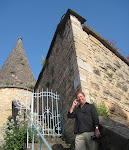 A Wildebeest
A WildebeestSome information about the wildebeest that inhabit the plains of the Serengeti: Also called the gnu, it is an antelope of the genus Connochaetes. It is a hooved (ungulate) mammal. Wildebeest stand anywhere from 4-5 feet at the shoulder, weigh 330–550 pounds and can live for more than 20 years. The principal food source of wildebeest is grass. The seasonal nature of the grasslands forces around 1.5 million animals to make an annual migration from the plains to the woods across
Early each morning and late in the afternoon we would hop aboard our jeep with our guide Didas and go looking for animals. Accompanying us was a German film maker trying to film some background material for a documentary he was making about witch craft in Tanzania for French TV. He was not the happiest of men when Didas refused to allow him out of the truck to film in areas that were not safe. You could tell the German was an adrenalin junkie. His accompanying sound man didn’t care much about anything except for his mobile phone.
and go looking for animals. Accompanying us was a German film maker trying to film some background material for a documentary he was making about witch craft in Tanzania for French TV. He was not the happiest of men when Didas refused to allow him out of the truck to film in areas that were not safe. You could tell the German was an adrenalin junkie. His accompanying sound man didn’t care much about anything except for his mobile phone.
I did get to see what I came for though…. The spectacular of thousands wildebeest crossing the 
 A line of wildbeest on the plain heading west
A line of wildbeest on the plain heading west















No comments:
Post a Comment